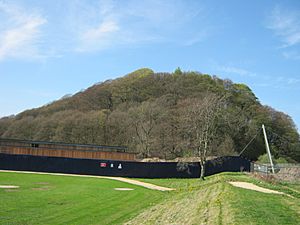Maiden Castle, Durham facts for kids
Quick facts for kids Maiden Castle |
|
|---|---|
 |
|
| Location | Durham, England |
| OS grid reference | NZ 283 417 |
| Area | 1.23 ha |
| Built | Iron Age |
| Governing body | English Heritage |
| Owner | Durham University |
| Designated | 14 December 1926 |
| Reference no. | 1008844 |
| Lua error in Module:Location_map at line 420: attempt to index field 'wikibase' (a nil value). | |
Maiden Castle is an ancient Iron Age fort located in Durham, England. It is known as a "promontory fort" because it sits on a piece of land that sticks out, often surrounded by water on several sides. Today, it is protected as a scheduled monument, which means it's an important historical site.
Contents
Why Here? The Fort's Location
Maiden Castle was built in a very smart spot. Even though the River Wear only touches one side of the site now, long ago, the river likely wrapped around three sides of the land. This made it a naturally strong place to defend. The river has since changed its path, but the old landscape shows why this location was chosen for a fort.
What It Looks Like: The Fort's Structure
Today, the area where Maiden Castle stands is covered with trees. But if you look closely, you can still see parts of the old fort, especially at its western end. These parts are called "earthworks," which are shapes made from earth, like banks and ditches.
The Fort's Shape and Size
The fort was built on a flat area. It had a large bank and an outer ditch that formed a wedge shape. This area was about 120 metres (around 390 feet) wide at its western end. It then became narrower, shrinking to 50 metres (about 160 feet) at the eastern end. The fort stretched for 145 metres (about 475 feet) from east to west.
Banks and Ditches
The main bank of the fort was quite big. It was about 6 metres (nearly 20 feet) wide and 5 metres (over 16 feet) high. The ditch was located more than 20 metres (about 65 feet) west of the bank. At its deepest point, the ditch was about 2 metres (over 6 feet) deep. These features helped protect the people inside the fort.
Finding the Entrance
It's not completely clear where the main entrance to the fort was. There's a gap in the ditch at the northern end, which might have been an entry point. Another possible entrance is at the very southern end. However, the area has been changed over time, making it hard for experts to be sure.
Inside the Fort: Stone Walls
Archaeologists have done some digging at Maiden Castle. They found clues that the inside of the earth bank might have been made stronger with a stone wall. During these digs, they even found a stone with a special mark from a stonemason. This mark tells us that some of the building work happened during the Middle Ages, long after the Iron Age.
What's in a Name? The Meaning of "Maiden Castle"
The name "Maiden Castle" has a couple of interesting possible meanings. One idea is that "maiden" here means something that looks very strong and impossible to capture. It could also mean a fort that has never been defeated in battle. Another thought is that the name comes from an old language called Brythonic. In this language, *moe din meant 'grassy plain'. So, the name might simply describe the landscape where the fort was built.

